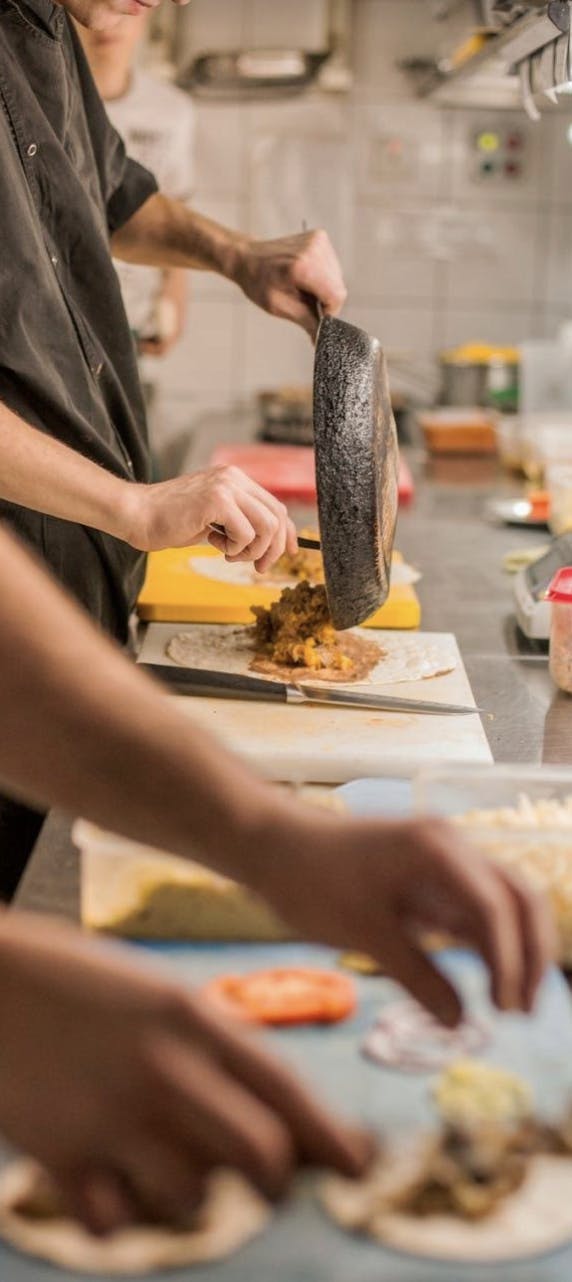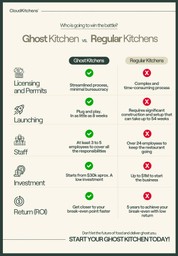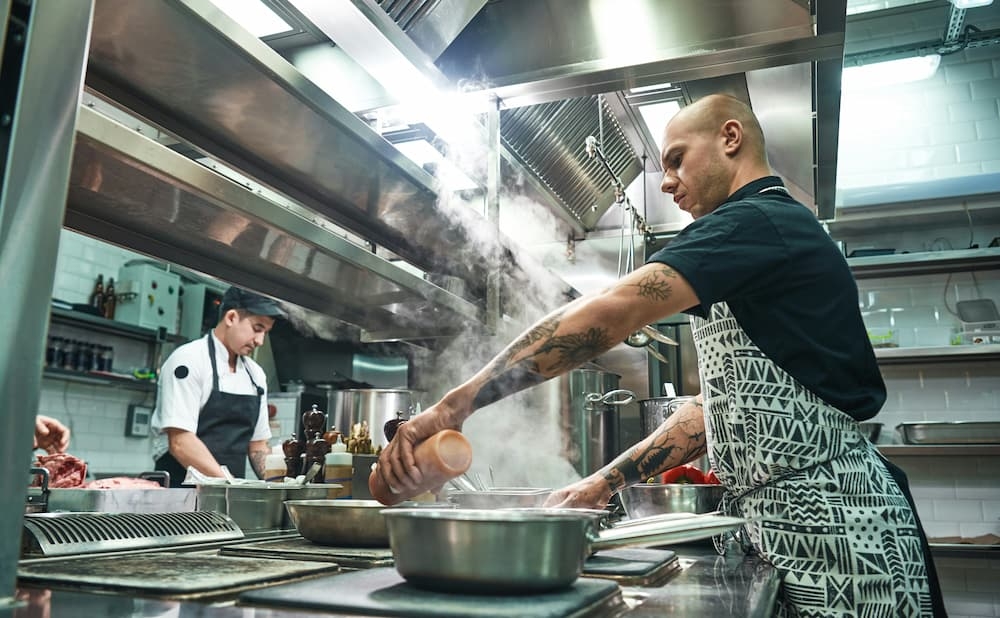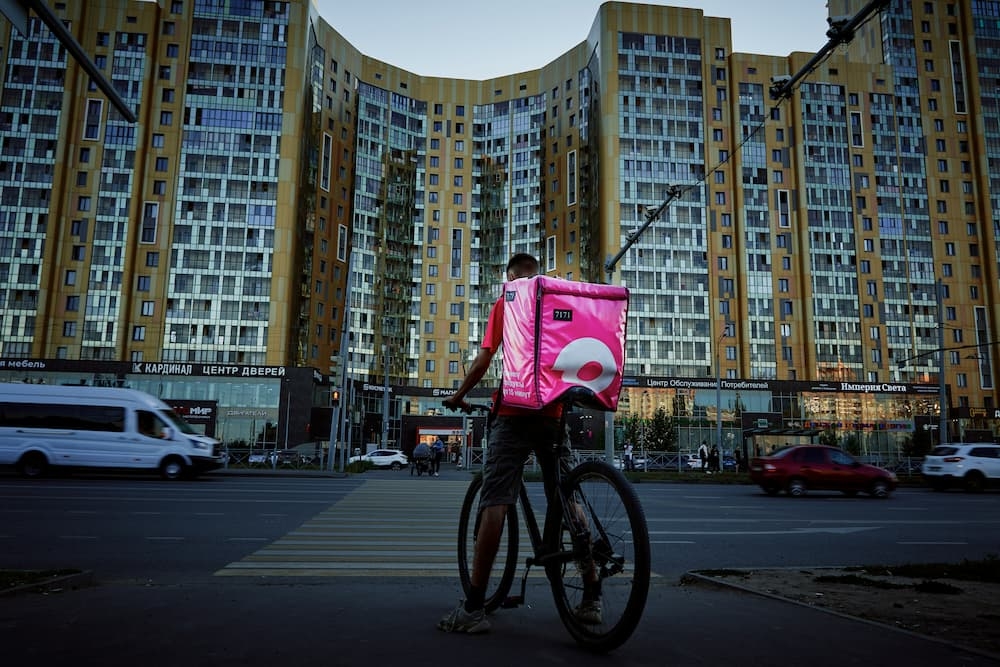Ghost Kitchen vs. Traditional Restaurant: Which One Is Right for You?
Table of Contents
CloudKitchens
How many tacos can be delivered from a 1000sqft restaurant?
The same amount as a 200sqft ghost kitchen.
In the food industry, the rise of food delivery has driven new operational models for restaurants.
While a traditional kitchen is the go-to option for those looking to open a physical restaurant, a ghost kitchen—also known as a ghost kitchen or cloud kitchen—has emerged as a leaner and more flexible alternative.
The key difference between a ghost kitchen and a traditional restaurant is customer service. While traditional restaurants welcome guests for dine-in and also offer delivery, a ghost kitchen operates virtually, focusing solely on delivery platforms.
But which model is more advantageous? To answer this question, let’s compare the structure, costs, flexibility, and return on investment of each option. Keep reading!
Which Model Is Best for Your Restaurant: Traditional Kitchen or Ghost Kitchen?
The choice between a traditional kitchen and a ghost kitchen depends on your business goals, target audience, and operational strategy. Both models offer advantages and challenges that can directly impact a restaurant’s profitability and operational efficiency.
A traditional kitchen serves both dine-in and delivery customers, providing a complete dining experience with ambiance, service, and direct customer interaction. On the other hand, a ghost kitchen operates exclusively through online food delivery, eliminating the need for a physical dining area and reducing costs related to staff and infrastructure.
Traditional Kitchen
A traditional kitchen is the most well-known model in the food industry. It operates within a physical restaurant, serving both in-house customers and delivery orders through online platforms.
This model offers a complete dining experience, including personalized service, a decorated ambiance, and a menu that can be tailored to the target audience.
However, running a traditional restaurant requires a higher initial investment, as it includes not only kitchen and equipment costs but also the construction or rental of a physical space to accommodate customers.
Additionally, operations require a larger team, including waiters, receptionists, and chefs, to ensure smooth service in both the dining area and the kitchen.
Licenses
To operate a traditional kitchen, a restaurant must obtain various licenses and permits to comply with health regulations and municipal laws. Some of the main requirements include:
- Business License: This is a general license required for most businesses, including restaurants. It’s obtained from your local city or county and allows you to legally operate your business within that jurisdiction.
- Employer Identification Number (EIN): This is a tax identification number issued by the IRS. It’s required for businesses that are corporations or partnerships, or that hire employees. You’ll need an EIN to file business taxes, open a business bank account, and apply for other licenses and permits.
- Certificate of Occupancy (COE): This document verifies that the building where your restaurant is located is safe and suitable for commercial use. It’s issued by your local building department and ensures that the building meets all building codes and zoning regulations.
- Food Service License: This license is specifically for businesses that prepare and serve food to the public. It’s issued by your local health department and ensures that your restaurant meets certain food safety and sanitation standards.
- Food Handler Permit: In many areas, anyone who handles food in a restaurant, including cooks, servers, and dishwashers, must obtain a food handler permit. This usually involves completing a food safety training course and passing an exam.
Obtaining these licenses can be a lengthy and bureaucratic process, increasing the time needed to open a restaurant.
Team
Managing a team in a traditional kitchen involves multiple professionals to ensure complete service. Key team members include:
- Chefs and cooks: Responsible for preparing dishes and maintaining kitchen organization.
- Kitchen assistants: Help with food handling, cleaning, and general organization.
- Waiters and receptionists: Serve customers, take orders, and deliver food.
- Managers: Oversee staff, supervise operations, and ensure service quality.
The team size varies based on the restaurant’s capacity, but overall, labor costs and employee benefits are significantly higher compared to models like ghost kitchens.
Customer Service and Interaction
Direct interaction is one of the biggest advantages of a traditional kitchen. Customers enjoy a complete experience, from the restaurant’s ambiance to personalized service. This connection helps build customer loyalty.
However, managing in-house service can be challenging, as any mistake can directly impact the restaurant’s reputation. Factors such as wait times and service quality must be carefully managed to ensure customer satisfaction.
Operational Costs
Operating a traditional restaurant involves high costs due to several factors:
- Rent for a physical location (often in prime areas, increasing expenses).
- Payroll for dining and kitchen staff.
- Utility bills (electricity, water, air conditioning, and kitchen equipment).
- Maintenance expenses (decor, furniture, and customer amenities).
These fixed costs can impact profitability, making the traditional model less flexible during economic downturns or demand fluctuations.
Flexibility
Traditional restaurant operations have less flexibility, as they follow fixed business hours and rely on in-house customer presence. Additionally, changes to the menu or business structure require careful planning and additional costs.
Traditional restaurants also face seasonal demand fluctuations, which can affect revenue.
Adapting to delivery services can be more complex, requiring logistical adjustments to maintain food quality during transportation.
Market Reach
A restaurant’s location largely determines its reach. It depends on foot traffic in the area and delivery orders from nearby customers.
To attract more customers, many restaurants invest in digital marketing, local promotions, and partnerships. However, business growth is often limited by the restaurant’s physical capacity.
Investment
The initial investment required to open a traditional kitchen is high, covering:
- Purchase of kitchen and dining equipment.
- Renovation and adaptation of the physical space.
- Hiring and training staff.
- Acquisition of necessary licenses and permits.
Depending on the restaurant’s size, the investment can range from $20,000 to $100,000 or more, requiring careful financial planning and a long-term return strategy.
Return on Investment (ROI)
A traditional restaurant’s ROI takes longer to materialize due to high fixed costs and the time needed to build a loyal customer base.
Even with high revenue, profits may be reduced by expenses such as rent, utilities, staff salaries, and maintenance.
Success depends on strong business planning, cost control, and customer retention strategies to ensure long-term sustainability.
Ghost Kitchen
The structure of a ghost kitchen is designed to maximize production efficiency and delivery logistics. Unlike a traditional kitchen, there is no need to invest in decor or in-person service, allowing for greater flexibility and lower initial costs.
Additionally, ghost kitchens can operate in shared kitchen spaces, further reducing investments in space and equipment.
Licenses
Although a ghost kitchen does not offer in-person service, it must still comply with sanitary and regulatory requirements.
Just like traditional kitchens, ghost kitchens must obtain certain mandatory licenses, such as Business License, Food Service Permit and EIN.
However, when a ghost kitchen operates in a shared space, many of these licenses are already provided by the kitchen operator, reducing bureaucracy for the business owner.
Team
The team management in a ghost kitchen is lean since there is no need for waiters or front-of-house staff. The key team members include:
- Chefs and kitchen assistants: Responsible for preparing the dishes.
- Packers: Ensure that orders are properly packaged and ready for delivery without errors.
- Operations manager: Oversees processes and ensures that orders are completed on time.
Customer Service and Interaction
Unlike traditional restaurants, customer interaction in a ghost kitchen is indirect, mainly happening through delivery platforms, social media, and digital customer support.
- Customer experience: Restaurant ratings depend on food quality, delivery time, and packaging.
- Digital communication: Many ghost kitchens use chatbots, social media, and messaging apps to interact with customers and answer questions.
- Customer loyalty: Strategies such as loyalty programs, discount coupons, and fast response times help build a recurring customer base.
The lack of in-person interaction can be a challenge, but well-managed digital engagement can make up for this limitation.
Operating Costs
The operational costs of a ghost kitchen are significantly lower than those of a traditional restaurant since there are no expenses for:
- Renting a commercial space in high-traffic areas.
- Interior decor and furniture for in-person service.
- A large team for front-of-house operations.
The primary expenses include ingredients, packaging for delivery, electricity, delivery platform fees, and transportation logistics.
In shared kitchens, such as those operated by CloudKitchens, these costs can be reduced even further.
Flexibility
Ghost kitchens offer much greater flexibility compared to traditional restaurants.
- 24-hour operation: Without restrictions on business hours, operations can be adjusted based on demand.
- Multiple brands: A single kitchen can host different brands and menus, maximizing profits.
- Quick adaptation: If a menu item is not well received, it can be replaced without significant operational impact.
This versatility allows the business to grow and quickly adapt to market changes, making it a highly scalable model.
Market Reach
Unlike brick-and-mortar restaurants that serve only customers in their immediate vicinity, ghost kitchens can expand their reach through well-structured delivery strategies.
- Partnering with multiple delivery apps: Increases visibility and attracts more customers.
- Strategic locations: Shared kitchens enable businesses to serve multiple regions, optimizing delivery coverage.
- Efficient logistics: The business model allows for testing new locations without major investments.
With a solid delivery plan, a ghost kitchen can reach a much larger audience than a traditional restaurant.
Investment
The initial investment to open a ghost kitchen is significantly lower than that of a physical restaurant, as there is no need for dining areas, furniture, or in-person service staff.
The primary costs include:
- Kitchen equipment.
- Delivery platform fees.
- Digital marketing for restaurants.
- Proper packaging for delivery.
Return on Investment
The return on investment (ROI) for a ghost kitchen tends to be faster than that of a traditional restaurant because:
- Operational costs are lower.
- The flexible model allows for quick strategic adjustments.
- The business can scale rapidly to serve new areas.
Depending on the planning and customer acceptance, the initial investment can be recovered within a few months, making it a profitable food business.
Is It Worth Investing in a Ghost Kitchen?
Yes, investing in a ghost kitchen can be an excellent strategy for food entrepreneurs looking to reduce operational costs, expand their business reach, and operate with greater flexibility. However, this decision should be evaluated based on a few key factors.
Although the differences between a ghost kitchen and a traditional kitchen are significant in terms of structure and operation, each model has its own advantages and challenges. It’s essential to consider:
1. Target Audience
Before investing in a ghost kitchen, it’s crucial to understand who your customers are and how they consume delivery services. Ask yourself:
- Is there demand for delivery in the chosen location?
- What are the consumption habits of the target audience?
- Does the market support another delivery operation?
2. Investment
The initial investment in a ghost kitchen is more affordable than that of a traditional restaurant, but it still requires financial planning. In addition to basic operational costs, consider:
- Fees for registration and licensing (including health and tax permits).
- Hiring a minimal operational team (chefs and kitchen assistants).
- Training to ensure production efficiency and food quality.
- Integration with order management systems and delivery platforms.
- Marketing efforts, including paid ads and brand identity creation.
3. Competition
The virtual kitchen market is growing rapidly, and competition is increasing as well. Before launching a business in this segment, analyze:
- How many restaurants operate via delivery in the area?
- What unique advantages can your ghost kitchen offer?
- Is there sufficient demand for the chosen niche?
4. Logistics
A ghost kitchen’s logistics must be highly efficient to ensure fast deliveries and fresh food. Some best practices include:
- Choosing a strategic location near key consumer hubs.
- Partnering with multiple delivery apps to maximize visibility.
- Using thermal and suitable packaging to maintain food quality.
- Planning efficient delivery routes to reduce delays and enhance the customer experience.
When Is the Best Time to Invest in a Ghost Kitchen?
Many entrepreneurs wonder when to transition to a ghost kitchen model, or whether it’s worth starting a new business focused exclusively on delivery. Here are some indicators that it may be the right decision:
Your Traditional Restaurant Is Underperforming
If your physical restaurant has high operational costs and low demand for in-person dining, switching to a ghost kitchen could be the solution to boost profitability.
You Want to Expand Your Service Area
If you’re looking to reach new customers without opening additional physical locations, a virtual kitchen allows you to expand your online food delivery reach with minimal investment.
Testing New Niches and Menus
A ghost kitchen provides flexibility to experiment with new dishes, cuisines, and culinary concepts without affecting a traditional restaurant’s operations.
You’re Looking for a Lean and Scalable Business
If you want a business model with lower costs, greater flexibility, and high growth potential, a ghost kitchen could be ideal for you.
It’s Time to Grow Your Business!
If you want to test the ghost kitchen model with more security and top-tier infrastructure, CloudKitchens is your best ally. With shared kitchens in strategic locations, your brand can grow without requiring a significant initial investment.
- Ready-to-use kitchens operational in less than a month.
- Up to 80% reduction in operational costs.
- Expanded delivery reach with strategic locations.
- Complete infrastructure and cutting-edge technology for order management.
- The ability to test multiple brands and menus within the same space.
Looking to expand your restaurant and operate more efficiently? Explore all CloudKitchens locations and find the perfect spot for your ghost kitchen! Get started today!
DISCLAIMER: This information is provided for general informational purposes only and the content does not constitute an endorsement. CloudKitchens does not warrant the accuracy or completeness of any information, text, images/graphics, links, or other content contained within the blog content. We recommend that you consult with financial, legal, and business professionals for advice specific to your situation.
More insights & stories
There’s more where that came from.
Get in the know and check out our additional insights



